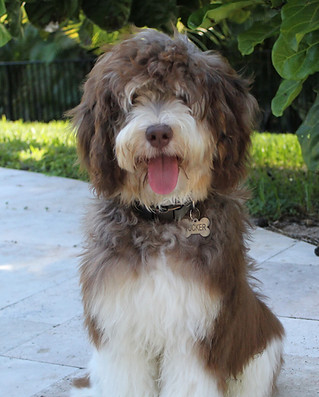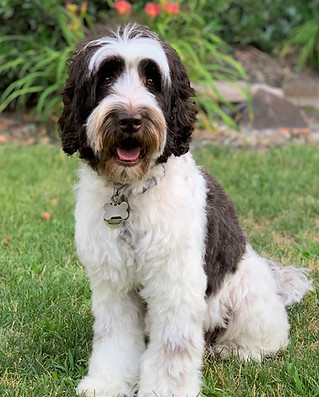
Australian Labradoodle Coat Colors
The Australian Labradoodle comes in a variety of coat colors and patterns. Each combination is beautiful in its unique expression. Lighting can change the colors, with summer sun often causing the outer coat to highlight in lighter shades. Silvering or graying may give the coat a distinctive look. Coats often have a slight to dramatic amount of softening of color over the years.
Black Pigment Colors
All of these coat colors describe an ALD with a black nose, black paw pads and dark eyes.

BLUE
A black coat with a blue caste. The coat begins black and mutes to a blue-tinted silver in time. The progression of the greying can turn the coat into a steel blue or muted dark blue with a splash of silver.

BLACK
Black coats remain a deep black color.

CHALK
Bright, crisp white

CREAM
Creamy, pearly tone

SILVER
A black coat that progresses to silver, can be charcoal to light gray.

APRICOT / GOLD
warm apricot tone, resembling the inside of a peach to warm rich gold tone

RED
Shades of red, dark orange or mahogany
Chocolate Pigment Colors
All of these coat colors describe an ALD with brown (also called rose colored) nose, brown paw pads and lighter eyes (usually hazel).

PARCHMENT
A chocolate coat that fades to a creamy beige, reminiscent of a cup of coffee with a generous addition of milk.

CHOCOLATE
The coat stays a dark, rich chocolate shade.

LAVENDER
A chocolate coat with a lavender caste that will progress to a greyish lavender, a smoky grey with a hint of lilac.

CAFE
A chocolate coat that fades to a milky or light chocolate color.

CARAMEL CREAM
Creamy, pearly tone

CARAMEL RED
Shades of red, dark orange or mahogany

CARAMEL ICE
Bright, crisp white

CARAMEL
warm apricot tone, resembling the inside of a peach to warm rich gold tone
Patterns
ALDs come in an array of beautiful coat patterns, each as stunning as the next.

TUXEDO
White markings clearly defined as a bib on the chest that can wrap around the neck. The belly, front and back legs and paws are also white. A faux tuxedo is used to describe a coat with most of these markings.

SOLID
Solid coats are one color or shade with no other markings or trait influences.

PHANTOM
Has a solid base color with sharply defined markings of a second color appearing above each eye, on the sides of the muzzle, on the throat/ fore-chest, on all four legs and feet, and below the tail.

PARTI
Over fifty percent of the coat is white, with the rest any base color.

WHITE MARKINGS
White markings are also called mismarks, spotting or abstract. These are splashes of white coloring typically seen on the tip of tail, chest, paws and face.

EXTREME PARTI
Most of the coat, in some cases all of the coat, is white. Sometimes just ear tips remain the base color.

TRI COLOR
A coat with three colors, such as a phantom or sable with white markings.

SABLE
This coloring ranges from a pale honey-gold color to a deep mahogany red. A dark colored coat fades to the lighter shade, leaving a sprinkling of the original color.

ROAN
Heavily mottled darker color on the white parts of the coat.

TICKING
Regular shaped spots, more like specks, on the white part of the coat. Not mottled like the roan coat.

MERLE
Members must agree to sterilize or place on non-breeding contract any merle patterned dogs produced.





